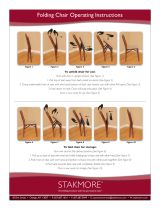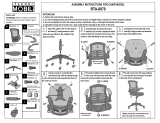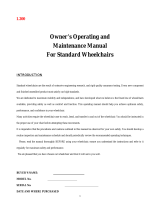Page is loading ...

Invacare®
Ben NG
User Guide
Ben NG
User Guide

2
Contents Page
Useful Symbols In This Manual 4
Warranty Terms & Conditions 5
Limitation of Liability 6
Introduction 7
Intended Use 8
1 Safety & Operating Limits 9
1.1 Weight Limit 10
1.2 Safe Slope 11
1.3 Reaching For An Object From A Wheelchair 12
1.4 Transferring To Another Seat 14
1.5 Tilting (Balancing On The Rear Wheels) & Obstacle Climbing 18
1.6 Steps, Stairs Or Obstacles Over 50mm High 20
1.7 Upward & Downward Slopes (Operating Limits) 21
1.8 Heat and Fire Warnings 22
2 Use 23
2.1 Folding & Unfolding The Wheelchair 24
3 Summary Of Safety Instructions 25
4 General Descriptions 26
5 Backrest 29
6 Seat 29
7 Armrests 31
8 Chassis 32
9 Rear Wheels 32
10 Castors 34
11 Manual Brakes 35
12 Footrest & Elevating Legrest 36
13 Heel support straps 39

3
14 Backrest Extension 40
15 Lap Belt 41
15.1 Types of Lap Belt 41
15.2 Lap Belt Adjustment 42
16 Routine Checks & Maintenance 43
17 Transportation 46
17.1 Using your wheelchair as a seat in a vehicle 46
17.2 Transporting your wheelchair as luggage 48
18 Storage 49
19 Cleaning 49
20 Product End Of Life 50
21 ISO 7176 part 15 51
Contacting INVACARE 52

4
Useful Symbols In This Manual
WARNING!
This symbol warns you of danger! Always follow the instructions to avoid injury to the user or damage to the
product!
NOTE:
This symbol identifies general information which is intended to simplify working with your product and which
refers to special functions.
REQUIREMENTS:
This symbol identifies a list of various tools, components and items which you will need in order to carry out
certain work.
TRANSPORTATION:
This symbol identifies important information relevant to transporting your wheelchair in a motor vehicle.

5
Warranty Terms & Conditions
Standard INVACARE Terms
This is to certify that your wheelchair is warranted by INVACARE Ltd. for a period of 2 years for parts and 5
years for frames.
1. Only INVACARE chairs purchased at full price are warranted against defective workmanship and materials.
2. If a defect or fault is discovered the INVACARE dealer from whom the wheelchair was obtained should be
notified immediately.
3. The manufacturer will not accept responsibility for damage caused by misuse or non-observance of the
instructions set out in the user manual.
4. During the period of the warranty any parts that have become defective, due to faulty workmanship or
materials, will be renewed or repaired without charge by the INVACARE dealer.
5. The warranty will be forfeited should any unauthorised alteration be made to the equipment.
6. The purchaser’s statutory rights under the Consumer Protection Act are not affected.

6
Limitation Of Liability
This warranty does not extend to the consequential costs from fault clearance, in particular freight and travel
costs, loss of earnings, expenses, etc.
• Natural wear and tear
• Inappropriate or incorrect use
• Defective assembly or setting-up by the purchaser or third parties
• Defective or neglectful treatment
• Use of unsuitable spares

7
Introduction
The User’s Manual for the INVACARE Ben NG & Ben NG HD range of transit and self propelling
wheelchairs is designed to provide guidance on their use and maintenance. The document also gives a brief
indication of the options that can be used as an alternative to the standard features. Ben NG & Ben NG HD
wheelchairs are designed for outdoor and indoor use, and can be folded to be placed in most vehicles. The
maintenance and safety checks mentioned in the manual should be carried out within the time scales covered.
If an accident or damage occurs whilst using your wheelchair, notify your source of purchase/issue
immediately.
Important: The contents of this manual should be read before using the wheelchair.
Note For Customers
INVACARE provides a wide range of wheelchairs to meet the requirements of customers. However, the
decision on the type of model to be prescribed rests exclusively with qualified advisers.
INVACARE or its appointed representative shall not be held responsible if a wheelchair is used that is
unsuitable for the user’s level of disability, if the wheelchair itself is incorrectly used or if a problem arises due
to poor maintenance.
The information set out in this manual may be modified without prior notice. This manual contains copyright
information. All rights are reserved. No part of this document may be photocopied or reproduced without
prior written agreement from INVACARE or its appointed representative.
This manual gives details of all the options of the Ben NG & Ben NG HD wheelchairs. It describes
the options, operation and adjustments that may be required. However, your INVACARE
retailer will be able to give you further information and demonstrations.
Safety Notice
Please ensure the wheelchair is fully opened and the seat rails are located in the seat saddles before sitting
down.

8
Intended Use
An indoor and outdoor configurable wheelchair offered with various options compliant with EN12183:2009.
The Ben NG & Ben NG HD manual wheelchair has been designed to provide mobility and comfort for
persons with impaired mobility.
The wheelchair has been designed to be used either/or by a seated user/carer/attendant in both indoor and
outdoor environments.
The Ben NG wheelchair has, in its standard transit or self propel format (15” - 18” seat widths), been
designed to accommodate users who weigh up to a maximum of 127kg (20 stone), have all limbs intact and
have sufficient upper body strength to maintain a safe position within the wheelchair without the addition of
supporting aids.
The Ben NG HD wheelchair has, in its heavy duty transit or self propel format (20”, 22” and 24” seat
widths), been designed to accommodate users who weigh up to a maximum of 160kg (25 stone), have all
limbs intact and have sufficient upper body strength to maintain a safe position within the wheelchair without
the addition of supporting aids.
Adaptations from the standard Ben NG & Ben NG HD wheelchair format are available to accommodate
users who do not meet the above criteria; these will only be considered after a suitable risk assessment has
been carried out by the product prescriber. When prescribing wheelchairs for use by full or partial amputees
(above or below knee, single or double) it is important to recognise that lower limb amputation will affect the
sitting centre of balance of the wheelchair. The impossibility of generalising the individual ability of a
wheelchair user means it is imperative that the product prescriber carries out a full stability evaluation to
ensure that the user is safe in the use of the wheelchair and the risk of the wheelchair tipping is minimised.
The wheelchair should only be used in accordance with the safety advice given within this user guide. Failure
to follow the recommended advice within this user guide could lead to personal injury.
No claims are made that the product will medically improve the circumstances or condition of the user.

9
1 Safety & Operating Limits
Stability and equilibrium
To ensure that the wheelchair remains stable and is manipulated correctly, you must always maintain good
equilibrium. Many actions cause the user of a wheelchair to reach out, lean over or move about within the
wheelchair and outside it. These actions will change your centre of gravity and weight distribution of the
wheelchair. Your wheelchair has been designed to remain stable for normal everyday use if it is used correctly
taking the precautions recommended in this manual.
1.1 Weight Limit
The maximum user weight limit is 127kgs (20 Stone) for Ben NG chairs with a seat width of 15” - 18” wide
chairs. The maximum user weight limit is 160kgs (25 Stone) for Ben NG HD 20” to 24” wide chairs.
The wheelchair user's degree of activity is important. For example, a very active user weighing 75Kg may
subject the wheelchair to more stress than a less active user weighing 115Kg. We recommend very active
wheelchair users to choose an appropriate design of wheelchair. Your INVACARE approved distributor will
advise you on the appropriate model.
The addition of a cushion will alter the centre of gravity and adversely affect the stability of the wheelchair.
The hanging of additional loads (back pack or similar items) onto your chair backposts can affect rearward
stability of your wheelchair and can cause the wheelchair to tip backwards causing injury.

10
1.2 Safe Slope
There is currently no recognised test method that will ensure repeatability and accuracy for determining
dynamic stability of a manual wheelchair.
Minimum Static Stability test results for the
Ben NG & Ben NG HD
wheelchair are as follows:
Forward facing uphill = 11.5°
°°
°
Forward facing downhill = 21°
°°
°
Sideways, across slope = 18.5°
°°
°
Based on these results Invacare estimate the maximum safe slope (dynamic) as 9 degrees
However, the maximum safe slope could vary depending on the ability of each individual.
Please consider the following before attempting to negotiate any slope:
Your / your attendants physical capability
Length of slope / distance to travel
Condition of surface being traversed - rough, wet or slippery surfaces etc will present additional hazards.

11
1.3 Reaching For An Object From A Wheelchair
(Note: All images showing a self propel wheelchair are
for illustrative purposes).
The limitations on reaching out from a wheelchair
shown in Figure 1 have been produced using a
representative sample of wheelchair users. Only the
arms should extend beyond the seat of the wheelchair.
For safety reasons, the body and head should remain
within the wheelbase.
Position the castors to give the longest possible wheel-
base (Figure 2). Lock the manual brakes on the rear
wheels.

12
Leaning Forwards
(Figures 3, 4 & 5)
With the wheelchair as close as possible to the object
you wish to reach, only reach out to take what is within
arm’s length in normal sitting position.

13
Leaning Backwards
(Figures 6 & 7)
With the wheelchair as close as possible to the object you wish to reach, only lean back for objects that are
within arm's length in normal sitting position.

14
1.4 Transferring To Other Seats
Leaning To One Side
(Figure 8)
This is a dangerous manoeuvre as it is easy to tip sideways.
When next to an object and leaning over, you must use the castors as a
means of keeping the wheelchair stable and balanced.
For your safety, it is essential to be in the correct position.
Do not try to pick something up from the floor if this would upset your
balance.
It is possible to move from and to a
manually propelled chair if the following
guidelines are followed. INVACARE does
not recommend any particular method
for transferring: This is the responsibility
of a medical adviser who should consider
your level of disability and type of
wheelchair. When transferring, either to
get out of or return to your wheelchair,
make sure that the gap between the two
seats is as small as possible.
(Figures 9 and 10)

15
When transferring, either to get out of or return to
your wheelchair, make sure that the manual brakes
on the rear wheels are on to prevent the wheel
moving (Figure 11).
Turn both castors towards the seat to which you
wish to move. Lift up the footplates (Figure 12).
Do not stand on the footplates.

16
If possible, swing the legrest hangers out to the
side to clear the passage (Figure 13).
If possible, remove the armrest on the side
between the wheelchair and the other seat
(Figure 14).

17
Note: Never stand on the footplates (Figure 15).

18
1.5 Tilting On The Rear Wheels & Obstacle Climbing
Tilting with assistance from a third person: The user should be sitting correctly and firmly in the chair or
if unable to support themselves, should be strapped in position to prevent them falling out of the chair. If a
wheelchair user needs assistance in tilting the chair, the assistant must know how to use his body correctly.
Keep your back straight and bend at the knee to tilt the wheelchair. Never exert too much force. The medical
team in charge of the user will advise you in the methods best suited to your morphology. The INVACARE
approved distributor will provide you with information on the risks of using the wheelchair incorrectly if the
wheelchair has removable parts such as armrests or leg rests.
These must NEVER be used as aids when lifting as they may inadvertently become detached and cause
injury.
To tilt the wheelchair (Figure 16), a third person
should grip the handles firmly. Warn the user of the
wheelchair before tilting it and remind him/her to
lean backwards. Check that the user's feet and hands
are clear of all the wheels. Place a foot on the foot
tipping lever and push smoothly until the wheelchair
is at the point of equilibrium. At this stage, the helper
will feel a difference in weight distribution. Turn the
wheelchair in the direction required and negotiate
the obstacle.
Lower the front of the wheelchair smoothly, holding
the handles firmly. Use your weight on the tipping
lever to act as a counterweight. Do not lower the
wheelchair suddenly for the last few centimetres
before returning to the normal position. This might
hurt the user.

19
Method 2 - Negotiating the obstacle backwards
(Figure 17)
The helper should stand on the pavement and turn the
wheelchair until the rear wheels are against the kerb.
Tilt the wheelchair backwards to the point of
equilibrium and, in a continuous movement, pull the
wheelchair until the rear wheels mount the kerb and
pass onto the pavement. Do not lower the castors to
the ground until you have pulled the rest of the
wheelchair sufficiently far to clear the kerb.
Note: Folding backs should always be checked to
ensure they are engaged.
17

20
1.6 Steps, Stairs Or Obstacles Over 50mm High
We recommend that you take very great care when taking a wheelchair up or down stairs. Two people are
required for this.
ADVICE TO THIRD PERSONS: Make sure that
you grip onto fixed, non-removable parts only.
Use the following procedure for going up stairs
(Figure 18): Tilt the wheelchair to its point of
equilibrium. One helper (at the back) holds the
wheelchair up against the first step, gripping the
handles firmly to lift. The second helper, holding
firmly a fixed part of the front frame, lifts the
wheelchair above the stairs and holds it while the first
helper places one foot on the following step and
repeats the operation. The wheelchair must not be
lowered until the last step has been negotiated and
until the chair is clear of the stairs.
Escalators
Do not use an escalator when moving a wheelchair
from one floor to another. This might cause serious
injury.
18
/




